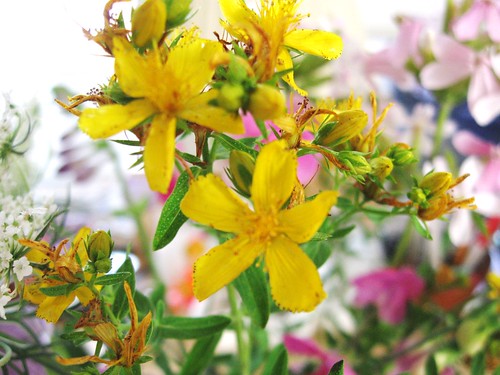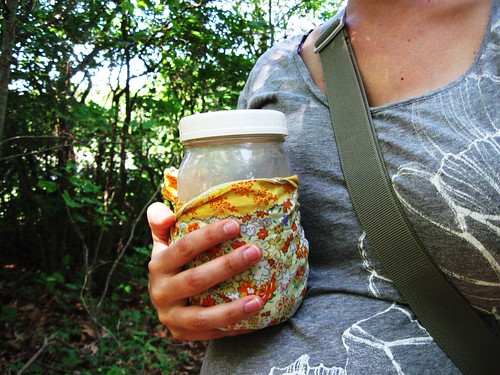
HERBAL PREGNANCY BLEND
Herbal pregnancy blend is a blend of herbs as a nourishing and toning support during your pregnancy and post-partum.
You will need the following:
1 pound Nettle leaf
½ pound Alfalfa leaf
1 pound Red Raspberry leaf
½ pound Oatstraw
1/4 pound Rosehips
Pour all herbs together, mixing well, in a jar or container.
************************************************************************
To prepare infusion:
Warm a quart glass jar under hot tap water.
Put one large handful of herbal mixture in empty, warm jar.
Pour boiling water into jar, making sure to stir down herbs.
Cover jar and leave overnight to extract nutrients.
In the morning, pour contents through a fine mesh strainer (the metal screening type with a handle works best). Rinse jar out and pour your infusion back into the jar. Discard or compost herbal material.
Drink entire quart over the day. You may dilute the infusion with water or herbal tea to taste if you wish. Be sure to work toward drinking the entire quart.
+++++++++++++++++++++++++++++++++++++++++++
ALFALFA (Medicago Sativa)
One of the richest mineral foods in the world, alfalfa’s roots grow as deep as 130 feet into the ground, allowing it to reach minerals not available at higher levels. The name “alfalfa” is Arabic and means “Father of all foods”.
Contains: Calcium, magnesium, phosphorus, potassium, chlorophyll, biotin, chlorine, inositol, iron, PABA, sodium, sulfur, tryptophan, Vitamins A, B complex, C, E, G, K, P and U.
Alfalfa is a restorative tonic which promotes pituitary gland function. It contains 8 enzymes known to promote a chemical reaction that enables food to be assimilated properly, helping to normalize weight, reduce incidence of ulcers, diabetes and other digestive disorders. It alkalinizes the body, reducing arthritis symptoms, neutralizing uric acid, improving kidney function and reducing edema. A toning agent to the intestines, it improves peristaltic action of the bowels, improving colon disorders and normalizing bowel movements. It contains anti-fungal properties. Alfalfa’s tryptophan levels help improve sleep patterns. In tablet form, alfalfa has been used successfully to reduce heart disease and improve arrhythmias. Alfalfa has been shown, in laboratory trials, to reduce cholesterol levels by reducing plaque.
************************************************************************
NETTLE (Urtica Dioica)
For those of you who have wandered into woodlands near water, stinging nettle will be a familiar memory. Nettle is a popular table green still today, eaten much the same way as cooked kale or spinach. Rich in chlorophyll, nettle is a world favorite for all urinary tract problems.
Contains: Chlorine, chlorophyll, formic acid iodine, magnesium, potassium, silicon, sodium, sulfur, tannin, Vitamins A and C, facilitates absorption of Vitamin D from the sun, proteins, iron, copper, histamine, glucoquinine.
Nettle is a gentle yet powerful tonic to the adrenals, and is known to rebuild the adrenal cortex, thus improving energy levels. It has been used with great success in the treatment of adrenal exhaustion, one of the primary underlying causes of Chronic Fatigue and a host of other auto-immune disorders. As the adrenals are the fundamental glands of immune health, Nettle is used to improve general immune function, thus increasing resistance to illnesses caused by viruses or bacterium. With its strong affinity to the adrenals, Nettle is used extensively to eliminate allergy and hay fever symptoms. It ha been used throughout time to restore kidney function, eliminating edema, cystitis, incontinence and urinary tract infections. Improving liver function, nettle reduces jaundice. The high Vitamin C levels in Nettle ensure that dietary iron is absorbed properly, thus reducing anemia. Its unique blend of nutrients stabilizes blood sugar, strengthening the nervous system and reducing headaches. By improving nerve signal to the muscle, Nettle helps increase muscle response time, thus reducing incidences of postpartum hemorrhage. By improving elasticity of the skin, Nettle helps prevent tearing of vaginal tissue. Combined with burdock root, Nettle is extremely helpful in the treatment of eczema. Nettle is an excellent promoter of abundant breast milk.
****************************************************************
OATSTRAW (Avena Sativa)
Oatstraw, as any livestock breeder will confirm, builds the strongest possible body, with the greatest resiliency. Used extensively in European cultures throughout time for health and beauty, our country has left this valuable herb slide into disuse.
Contains: Starch, silicic acid, calcium, high in Vitamin A, B complex, C, E, G, phosphorus, potassium, niacin, and proteins.
Oatstraw contains Avenin, an amorphous alkaloid which is highly nutritive to cells, improving normal cellular reproduction. Its calcium form is so easily absorbed that oatstraw is considered the premier herb/food for the nervous system. Working directly on the brain and endocrine system, oatstraw reduces nervous disability, anxiety and epilepsy. Due to its ease of absorption, oatstraw has been used with great success in addiction recovery. As calcium is responsible for the enzymatic process by which nutrients are laid down in the muscle, oatstraw improves muscle tone throughout the body, reducing leg cramps and heart palpitations, improving digestion and elimination. Improving muscle tone allows the cardiovascular system to function more vigorously thus improving circulation to the uterus and placenta, and therefore, to the pre-born infant. Its high levels of minerals make oatstraw invaluable in building excellent bone density and enamel on teeth. Oatstraw’s high levels of silicic acid are responsible for its’ international fame in skin disorders such as acne and relief from topical inflammations such as chicken pox and poison ivy. Oatstraw, in cases of allergic reactions seems not to affect the individual to the same degree as the oat grain itself and is often used, without aggravation by those who cannot eat oats.
*************************************************************
RED RASPBERRY (Rubus scrigosus or idaeus)
Likely the most well-known pregnancy herb, red raspberry ha been used throughout Europe and the Americas for centuries as the premier childbearing years herb. Growing easily in almost every environmental condition, even the youngest country child can identify the wild, briary canes as they overtake everything in their path.
Contains: Fruit sugar, pectin, citric acid, malic acid, silicon, Vitamins C, B2, niacin, carotene, magnesium, manganese, molybdenum, selenium, improves Vitamin D absorption.
Red raspberry is a specific muscle toner, working on the smooth muscles of the body, including the uterus. As it soothes spastic muscle behavior, it improves contractibility of the uterus during labor. The particular properties of the herb tone and nourish the ovaries, and by relationship to the pituitary, reduces nausea, morning sickness, and intestinal spasm caused by excess progesterone. This same relationship has made Red Raspberry a popular herb for menstrual cramps and hot flashes. Due to its astringent qualities, it is used for mouth ulcers, bleeding gums, hemorrhage, hemorrhoids and cold sores. The unique mineral blend in Red Raspberry promotes healthy nails, bones, teeth and skin.
************************************************************
ROSEHIPS (Rosa canina)
Rose hips develop on wild roses as the flowers drop off. The rose hip, also called the rose haw, is actually the fruit of the rose. They are one of the most concentrated sources of vitamin C available, which has led to rose hips being included in many common cold preventives and remedies.
Contains: Vitamins A, C, D, E, flavonoids, lycopene, iron
While the efficacy of vitamin C in preventing the common cold has been questioned, there's no doubt about the beneficial effects of vitamin C. In addition to C, rose hips also contain A, D and E, as well as antioxidant flavonoids that may reduce the effects of aging and help prevent cancer. All this is wrapped up in the tart-sweet taste of the miniature fruits. They can be used to make jelly, jam, soup or oil. During World War II, the British government used collected rose hips to make rose hip syrup as a source of vitamin C to replace citrus fruits that were impossible to get. Rose hips have a long history of use in traditional medicine. The iron in rose hips make them an excellent supplement for menstruating women, and rose hip tea is a rich source of vitamin C, carrying all the benefits of that vitamin. In addition, the various flavonoids in rose hips have potent antioxidant action, helping to protect the body from the effects of stress, aging and the environment.














